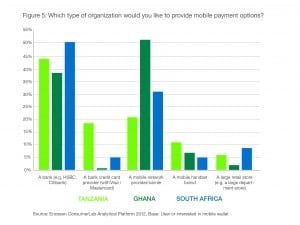Ericsson Report Underlines Satellite Opportunity in Mobility

Survey of mobile payment option preference from left to right: Tanzania, Ghana and South Africa. Photo: Ericsson
[Via Satellite 11-11-13] Ericsson’s latest Mobility Report gives the latest trends in the wireless industry, which will have a direct relevance to the satellite industry, given the need for cellular backhaul services over satellite. The numbers are quite staggering, and growth rates both in terms of overall mobile subscriptions and mobile broadband subscribers are still seeing healthy increases. One of the key statistics of the report is that mobile broadband subscriptions will go across the two billion threshold in 2013. Overall, Ericsson says there are over 6.5 billion mobile subscriptions globally. It is predicted that there will be over nine billion mobile subscriptions by the end of 2013. Mobile broadband subscription numbers are expected to explode over the next six years, with the numbers reaching eight billion by 2019.
When asked what direct implications these numbers will have on the satellite industry, Peter Jonsson, director of business intelligence at Business Unit Networks, Ericsson, told Via Satellite, “The growth in high-speed mobile broadband consumers and devices will influence the consumption of media and video as we already see today. Consumers want immediate access to content on every connected device. The satellite industry is providing consumer fixed TV services today and must evolve by 2019 to embrace a bi-directional, broadband IP connection in addition to the one-way satellite delivery for these TV services. This will enable greater personalization and on-demand consumption services. Mobile broadband could provide this connectivity.”
In terms of where satellite will fit in in terms of the overall mobile eco-system, Jonsson added, “The satellite industry is serving business, applications and consumer services in multiple ways and mobile broadband will drive effects in different ways. Consumer services for TV will shift slowly towards increased needs for IP delivery of on-demand and personalized content. Low speed data services for M2M applications and monitoring can shift towards mobile broadband. There will be many applications for connectivity of devices to mobile networks. This is Ericsson’s prediction of 50 billion connected devices by 2020.”
Interestingly, the growth in markets such as Asia, Middle East & Africa, key targets for satellite players in terms of backhaul is one of the main reasons for the increase of smartphone subscriptions, which Ericsson predicts will rocket from 1.9 billion at the end of 2013 to 5.6 billion in 2019, with growth in the emerging markets seen as a major factor behind this. Jonsson added, “Around 55 percent of all mobile phones sold in Q3 2013 were smartphones and the growth of smartphone data traffic passed that of mobile PCs, tablets and mobile routers in 2013. Smartphone subscriptions growth will drive mobile traffic with low-price smartphones to further fuel this. Mobile data traffic grew by 80 percent between Q3 2012 and Q3 2013, and is expected to grow around 10 times between 2013 and 2019, driven mainly by video.”
Asia, with its large overall population, will continue to pace the world in terms of overall subscriptions with 4.7 billion mobile subscriptions in 2019, according to Ericsson. In Latin America, Ericsson predicts that by 2019 WCDMA/HSPA will be the dominant technology, but that GSM/EDGE subscriptions will still be “significant”. Perhaps some of the most interesting dynamics will take place in the Middle East & Africa, where Ericsson says “dramatic” changes will start to take place. The report says that as of 2013, 80 percent of subscriptions in the Middle East & Africa are based on 2G. In 2019, the 80 percent figure is expected to represent 3G/4G as new technologies take hold in these regions. In terms of other regional trends, Jonsson adds, “We foresee a technology shift in all regions. Today most developed markets have a dominance of WCDMA/HSPA subscriptions, which will shift towards LTE in the coming years. In 2019, 85 percent of the North American mobile subscriptions will be LTE. In developing markets we see a similar shift, but from 2G to 3G. In [the] Middle East & Africa 80 percent of the mobile subscriptions are 2G as of 2013. The same number will be 3G/4G in 2019. For people this means a shift from mainly voice coverage to Internet coverage.”
The way we are using mobile phones is also changing. The growing use of video on mobile devices is also highlighted in the report. 2019 is expected to be a key inflection point for video, with its applications consuming over 50 percent of global mobile traffic in 2019. “The main driver of traffic growth is video, where not only additional mobile broadband spectrum will enable this growth to be met, but also the deployment of new video compression technology. Ericsson expects HEVC to have a key role in mobile video delivery in the future, saving approximately 50 percent of the bandwidth for the same quality of video,” adds Jonsson.